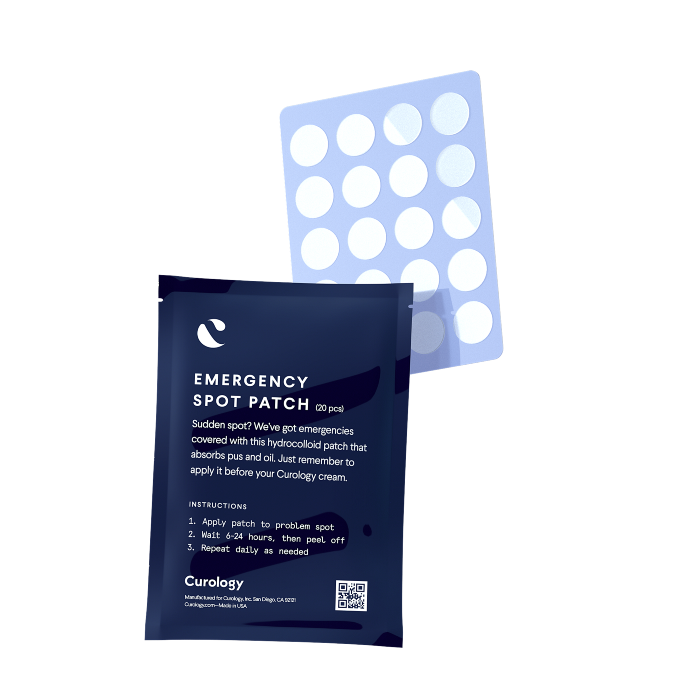How it works:
Share your skin goals and snap selfies
Your dermatology provider prescribes your formula
Apply nightly for happy, healthy skin
How it works:
How it works:
Share your skin goals and snap selfies
Your dermatology provider prescribes your formula
Apply nightly for happy, healthy skin
How it works:
Ask Curology: Can a spot patch get rid of pimples overnight?
The science of hydrocolloid bandages, explained.



Welcome to Ask Curology, penned by one of our in-house medical providers in response to your questions about all things skincare. This week: we’ve said before that pimple patches are fast-acting — but just how fast are they? We’re calling for a reality check on these so-called overnight spot treatments.
Dear Curology,
Instant gratification is my MO. So, normally, when I get a big juicy zit, I pop it. A thousand scabs and scars later, I know I need to change my ways. I read your blog post about emergency spot patches, so I’m curious — but also highly skeptical. How is it possible for a hydrocolloid bandage to treat my acne? And how fast do they really work?
Signed,
Impatient Patient
Dear Impatient,
I get it — popping an inflamed blemish can be SO satisfying. But the older I get, the more I regret my decision to pick. I, too, was wary of hydrocolloid bandages at first. How could a bandage that I normally use for blisters help with acne on my face? Well, it turns out that they can help a lot.
Let’s be clear: a hydrocolloid bandage is not a “miracle cure” for acne. I can’t promise that when you apply one at night your pimple will be completely gone by the morning. They can help shrink the lesion and speed healing, but the healing time will likely vary — not just from person to person, but also from blemish to blemish!
How do hydrocolloid bandages work?
Hydrocolloid bandages (a.k.a. acne patches or spot patches) can help draw out the contents of inflamed acne lesions and reduce healing time. Spot patches work like sponges to absorb pus and oil from blemishes while also reducing inflammation. Because the bandages cover the lesion, they can protect the area from contamination and help prevent picking and popping, minimizing the chance of scar formation.
Hydrocolloid bandages are “occlusive” or “semi-occlusive.” This means they prevent water vapor from leaving the surface of the pimple. This creates a moist environment and allows for faster healing, as skin cells cannot easily migrate across a dry scabbed surface to heal the lesion.
One last thing: hydrocolloid bandages are great in a pinch, but, as I’ve already said, they’re not really a “cure” for acne. It’s best to rely on your custom Curology formula (or other acne treatment) to help meet your skin goals.
How to use a hydrocolloid bandage
Using a hydrocolloid bandage is easy! Just follow these simple steps:
Cleanse your skin with water or a gentle cleanser and let it dry.
Apply the hydrocolloid bandage to the acne lesion.
Leave the bandage on for 6–24 hours.
Take the bandage off.
Repeat daily as needed.

As you know, IP, Curology recently launched the emergency spot patch, our own version of the hydrocolloid bandage. Our spot patch was designed to stand out from the rest: 1) it’s ultra-thin, so you can wear it out and about throughout the day (and even apply makeup on top); 2) it’s free of harsh active ingredients, so it’s gentle enough for sensitive skin.
If you’re new to Curology, you can get your first month free — it just costs $4.95 (plus tax) to cover shipping + handling. If you’re new to Curology, you’ll have the option to add the emergency spot patch to your trial box. If you’re already a Curology member, you can update your 2-month subscription plan to include spot patches for $4.95 more per box.

Start your free trial (plus shipping and handling)
I hope this helps! As always, feel free to sound off in the comments if you have any more questions, or get in touch with your Curology medical provider for a consultation.
All my best,
Nicole Hangsterfer, PA-C
We’re here to share what we know — but don’t take it as medical advice. Talk to your medical provider if you have questions.

Nicole Hangsterfer, PA-C